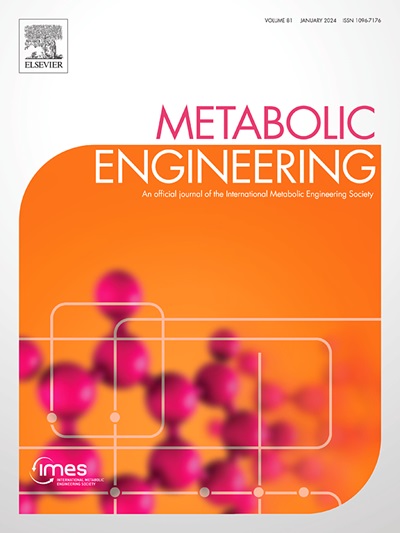l -缬氨酸过量产生的代谢途径的多层转录和翻译后微调。
IF 6.8
1区 生物学
Q1 BIOTECHNOLOGY & APPLIED MICROBIOLOGY
引用次数: 0
摘要
l -缬氨酸是一种必需氨基酸,广泛应用于食品、制药和动物饲料行业。目前,工程微生物细胞工厂以低成本原料生产l -缬氨酸已成为一种主要策略。然而,仍然缺乏一种l -缬氨酸生产菌株,同时表现出高滴度,高产率和高生产力。据报道,l-缬氨酸生物合成的代谢工程策略主要依赖于传统的一维转录水平修饰,这限制了微调,不能提供全面的、多层次的调控。在这项研究中,我们通过多重转录和翻译后的代谢途径微调构建了大肠杆菌l -缬氨酸高产菌。最初,利用启动子工程策略消除了l -缬氨酸合成途径中的转录抑制。然后,采用“推-拉-抑制”和运输工程策略提高L-valine积累,达到了21.6 g/L的烧瓶发酵滴度和0.45 g/L/h的产率。随后,我们合理设计无膜细胞器(MLOs),实现代谢生物合成的空间调控,增强了二羟基酸脱水酶和支链氨基酸转氨酶的靶向募集。这种空间重组使生产力提高了95.6%,达到0.88 g/L/h。结果表明,最佳菌株在3-L生物反应器中28h产L-valine 90.6 g/L,产糖量为0.48 g/g,产率为3.24 g/L/h。据我们所知,这代表了迄今为止最高的l -缬氨酸生产力。我们的策略提供了一种实用有效的方法,通过多层转录和翻译后代谢途径的调节来推进微生物氨基酸的生物合成。本文章由计算机程序翻译,如有差异,请以英文原文为准。
Multi-layered transcriptional and post-translational fine-tuning of metabolic pathways for overproduction of L-valine
L-valine is an essential amino acid widely used in the food, pharmaceutical, and animal feed industries. Currently, engineering microbial cell factories to produce L-valine from low-cost feedstocks has emerged as a leading strategy. However, there is still a lack of an L-valine-producing strain that simultaneously exhibits high titer, high yield, and high productivity. The metabolic engineering strategies reported for L-valine biosynthesis primarily rely on conventional unidimensional, transcriptional-level modifications, which limit fine-tuning and do not provide comprehensive, multi-layered regulation. In this study, we constructed an Escherichia coli hyperproducer of L-valine by multiplexed transcriptional and post-translational fine-tuning of metabolic pathways. Initially, the transcriptional repression in L-valine synthetic pathway was eliminated by using promoter engineering strategy. Then, the “push-pull-inhibit” and transport engineering strategies were used to improve L-valine accumulation, achieving a flask fermentation titer of 21.6 g/L and a productivity of 0.45 g/L/h. Subsequently, we rationally designed membraneless organelles (MLOs) to enable spatial regulation of metabolic biosynthesis, which enhanced the targeted recruitment of dihydroxy-acid dehydratase and branched-chain amino acid aminotransferase. This spatial reorganization led to a 95.6 % increase in productivity, reaching 0.88 g/L/h. Finally, the best-performing strain produced 90.6 g/L L-valine in a 3-L bioreactor at 28 h, with a yield of 0.48 g/g glucose and a productivity of 3.24 g/L/h. To the best of our knowledge, this represents the highest L-valine productivity achieved to date. Our strategy provides a practical and effective approach for advancing microbial amino acid biosynthesis by multi-layered transcriptional and post-translational regulation of metabolic pathways.
求助全文
通过发布文献求助,成功后即可免费获取论文全文。
去求助
来源期刊

Metabolic engineering
工程技术-生物工程与应用微生物
CiteScore
15.60
自引率
6.00%
发文量
140
审稿时长
44 days
期刊介绍:
Metabolic Engineering (MBE) is a journal that focuses on publishing original research papers on the directed modulation of metabolic pathways for metabolite overproduction or the enhancement of cellular properties. It welcomes papers that describe the engineering of native pathways and the synthesis of heterologous pathways to convert microorganisms into microbial cell factories. The journal covers experimental, computational, and modeling approaches for understanding metabolic pathways and manipulating them through genetic, media, or environmental means. Effective exploration of metabolic pathways necessitates the use of molecular biology and biochemistry methods, as well as engineering techniques for modeling and data analysis. MBE serves as a platform for interdisciplinary research in fields such as biochemistry, molecular biology, applied microbiology, cellular physiology, cellular nutrition in health and disease, and biochemical engineering. The journal publishes various types of papers, including original research papers and review papers. It is indexed and abstracted in databases such as Scopus, Embase, EMBiology, Current Contents - Life Sciences and Clinical Medicine, Science Citation Index, PubMed/Medline, CAS and Biotechnology Citation Index.
 求助内容:
求助内容: 应助结果提醒方式:
应助结果提醒方式:


